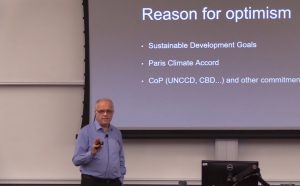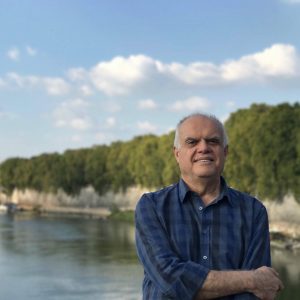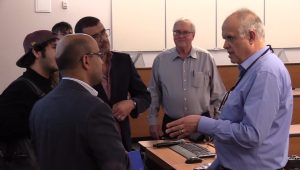Summary from Innovation Talk:
“FEEDING THE WORLD IN A CHANGING ENVIRONMENT”
Presented by Olcay ÜNVER, PhD.
January 25, 2018
McCord Hall, Arizona State University, Tempe, Arizona
This talk is about the challenge of feeding an increasingly hungry world against a backdrop of resource degradation, inefficiencies, loss and waste, and the impacts of a changing climate. The state of affairs in many of these are far from desirable, and some are projected to worsen as the competition for natural resources increases. Yet, there is reason for optimism, manifested in some of the trends that we are now observing and in the resolve of the international community, that is, governments, civil society and private sector to address the challenge.
The latter include the 2030 Sustainable Development Agenda, Paris Climate Agreement, and the Nationally Determined Contributions within the framework of the UN Framework Convention on Climate Change (UNFCCC).
There are now 815 million people suffering from chronic hunger now.
The challenge of feeding the world is well recognized and addressed at levels from national to global. Fight against chronic hunger has been high on policy agendas and much progress has been done to pull hundreds of millions out of poverty and hunger, which resulted in a steady decline in hunger and malnutrition for over a decade. Unfortunately, this past year was a turning point when the chronic hunger figures started rising again. There are now 815 million people suffering from chronic hunger now.
The past year marked another turning point in nutrition statistics: it was the first year in records when the number of deaths due to overweight and obesity exceeded the number of deaths due to underweight and hunger. In fact, adult obesity is on the rise in ALL regions of the world and childhood obesity in most regions, irrespective of the level of economic development.
 FAO projections indicate that the global demand for food will increase by nearly 50% by 2050 over the 2012 figures. Producing more food will mean mobilizing more resources, which mean more water, land and energy. OECD estimates that water demand may increase by 50% to 55% by 2050 and Water Resources Group 2030 warns that business as usual will result in a supply-demand gap of 40% by as early as 2030.
FAO projections indicate that the global demand for food will increase by nearly 50% by 2050 over the 2012 figures. Producing more food will mean mobilizing more resources, which mean more water, land and energy. OECD estimates that water demand may increase by 50% to 55% by 2050 and Water Resources Group 2030 warns that business as usual will result in a supply-demand gap of 40% by as early as 2030.
Our natural resources, which are expected to support the effort in closing this gap face multiple challenges. Land degradation is a major problem, which currently renders one third of all land unproductive on a global scale. Half of the world’s fertile top soil has been lost over the past 150 years and we are only recently coming to terms that no technology or efficiency improvement in water use or agriculture practices would make a difference without healthy soils. Insect populations are on the decline at an alarming rate, with many implications on the life on the planet, as well as on agriculture and food production.
We lose or waste one third of all food produced worldwide.
Yet, we lose or waste one third of all food produced worldwide. FAO reports that this happens more due to lack of proper facilities and infrastructure (e.g. storage, cooling, transportation) in developing countries while it occurs more due to wasteful practices (e.g. supermarkets and homes) in developed countries. The food loss and waste translate into waste of the resources used in the production and have significant implications on climate change.
An obvious area of intervention, through policies, regulation, incentives, targeted investments and innovation, is the food value chain, from production to consumption, or from farm to fork.
On the production end, much potential exists for improving water use efficiencies and agricultural productivity through better land, water and soil management, improved seeds, better livestock practices and forest management.
Processing and manufacturing industries can be more water-efficient and resource-sensitive from site selection to shipping and can encourage their supply chain to do so, too.
Huge potential exists in reducing food loss and waste, which can help feed the hungry, relieve pressure on water, land and energy and decrease GHG emissions.
All of the above corresponds targets of Sustainable Development Goals, particularly SDGs 2, 6, 12, 13, and 15.
The agriculture sectors, crop production, livestock, aquaculture and fisheries and forestry, have become both a cause and victim of climate change for too long. The recognition of agriculture’s potential at the Climate Summit in Paris in 2016 (COP21) and the continued coverage the following year at COP22 finally bore fruit last year in Bonn at COP23, where the parties agreed to move agriculture to the joint agenda of the two subsidiary bodies of the UNFCCC, SBSTA and SBI (Koronivia Joint Work on Agriculture).
These underline a need for focused policies and associated actions that take into account the broader frameworks rather than the more typical, isolated, silo-style interventions.
I would like conclude by highlighting an initiative of FAO and its partners as a contribution to these efforts: the Global Framework on Water Scarcity in Agriculture in a Changing Climate (WASAG). This initiative has been launched during COP22 and has now developed into a partnership of more that 50 members including countries, public, civil and private sector entities, UN agencies and membership organizations. Its rationale is the observation that no single organization is able to deal with the multiplicity and diversity of issues involving agriculture and food systems under water scarcity conditions. WASAG’s aim is to assist the governments and stakeholders with coordinated, holistic solutions to deal with these while creating adaptation and mitigation benefits.
– . –
 Biography of Olcay Ünver, PhD.
Biography of Olcay Ünver, PhD.
Deputy Director of Land and Water Division, Food and Agriculture Organization of the United Nations, is responsible for managing water, land and soil-related activities and programs at FAO, mainstreaming water across the various sectors and disciplines, and cooperating with partners and stakeholders within and outside the UN system.
Prior joining to FAO, Mr. Ünver was the Coordinator of the United Nations World Water Assessment Programme of the UN-Water and the Director of UNESCO Programme Office on Global Water Assessment in Perugia, Italy. And, prior to joining UNESCO in 2007, he was with Kent State University, USA where he was a distinguished professor of water resources since 2004. During his time at Kent State, he founded the Euphrates-Tigris Initiative for Cooperation (ETIC), a track-two program that aims to support and strengthen the track-one efforts in the Euphrates-Tigris basin. He served for 13 years as the president of the Southeastern Anatolia Project (GAP) Regional Development Administration in Turkey. Dr. Ünver also has participated in various international organizations such as as a Board Member and the Treasurer of the World Water Council (1995-2003); Vice-President and Secretary-General of the International Water Resources Association (2001-2006) and a council member of the International Hydropower Association (1997-2000). He was named “a European Visionary” by the Time Magazine in 1999. Mr. Ünver holds a Ph.D. in Civil Engineering from The University of Texas at Austin, USA and Master’s and Bachelor’s degrees, also in Civil Engineering, from Middle East Technical University, Ankara, Turkey.
Source: http://www.un.org/ga/president/64/thematic/water/OlcayUnver.pdf
Full presentation is available in the following link: https://vimeo.com/252914191
Posted on 18 February 2018, Turkish Library Museum – www.turkishlibrary.us, is under the umbrella of The Light Millennium Organization based in New York. Officially formed in 2001.
NGO Associated with the United Nations Department of Public Information since 2005.


